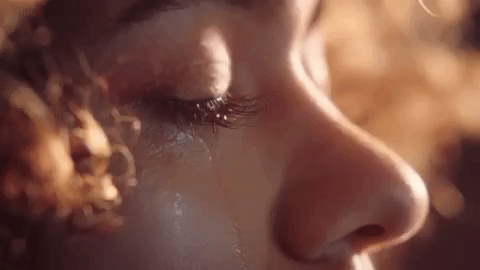Anatomy of Chronic Sadness [ Neuropsychology of Dysthymia ]
Hello friends steemians persistent depressive disorder does not always respond to the pharmacological approach. This chronic apathy, that hopelessness and bad humor have a more complex origin than we can think. Thus, the neuropsychology of dysthymia reminds us that this condition is related to a series of brain processes and social situations to be taken into account.

Sometimes I feel you fall apart
When we review the incidence of dysthymia in the population there is a detail that we can not ignore. Clinical studies tell us that this disorder affects 5% of the population, especially women. Now, if there is something that specialists know well is that there are many people who live in their day to day with this psychopathological picture without taking the step, without asking for help. This helplessness and dejection is chronicled in such a way that the probability that the incidence data are greater than we think is great.
Dysthymia, or more recently "persistent depressive disorder", affects women to a greater degree and is characterized by low mood, fatigue and recurrent sadness. They are states that can drag on for years.
On the other hand, it should be noted that since the last volume of the Diagnostic and Statistical Manual of Mental Disorders (DSM-V) changed the term "dysthymia" to that of persistent depressive disorder, more and more studies have continued to be carried out. a single purpose The purpose of the medical and scientific community is to be able to delimit and understand this condition much better. We are facing a much milder disease than major depression. However, given the difficulty in treating this condition, it is common that many patients end up deriving at some point in other conditions and mental disorders.
Neuropsychology of dysthymia (persistent depressive disorder)
It was the psychiatrist Robert Spitzer who in the 60s coined defined and "purified" this clinical condition, differentiating it from other unsuccessful terms. Until this famous specialist did not strive to improve and polish the classification of mental illness, dysthymia was related rather to a personality type. Defined those people with a depressive, neurotic and weak mood.
From the 1960s to the present, persistent depressive disorder continues to be refined in order to get to the root of the problem. Thus, and for a person to receive this diagnosis, the following qualifying conditions must be met:
* Depressive mood with a minimum duration of 2 years.
* Presence of at least two of the following characteristics
Loss or increase of appetite.Insomnia or hypersomnia.Lack of energy or fatigue.Low self-esteem.Deficits of concentration or difficulties in making decisions.Feelings of hopelessness
* Upset, continued suffering.
* There are no psychotic episodes, maniacs, or other organic illnesses or suspicions of major depression.
What happens in my brain if I am diagnosed with a recurrent depressive disorder (dysthymia)?
When a person receives the diagnosis what they experience many times is relief. This is so for an obvious reason. There are those who have been dragging that shadow since adolescence. That emptiness that entered constantly through a half-open door to let loose the despondency, and that lingering smell of sadness that envelops everything.
The neuropsychology of dysthymia tells us that this condition has an origin. It is believed that stress and that increase in catecholamines and hormones such as cortisol, affect our ability to regulate mood.
* Clinical research, and especially the advancement in brain imaging technologies, such as magnetic resonance, have given us the opportunity to discover very revealing data. One of them is the presence of low activity in all those brain areas related to problem solving, sleep regulation, appetite and even our sociability.
* Most of these processes are focused on a very special area. It is the anterior cingulate cortex, responsible for executive and emotional control, which evidences, as we say, a low activity in all patients with recurrent depressive disorder.

The cingulate cortex and the neurons of Von Econome
* The anterior cingulate cortex is part of a network responsible for generating multiple processes. It helps us process information, both sensory and emotional. It helps us to maintain attention while we move or interact with others. It is she who facilitates that we maintain interest in our environment, which acts as a bridge between emotion and attention.
* Also, in this brain area there are also the so-called Von Econon neurons. We have all heard about mirror neurons, but the latter also require our interest in a key reason. These nerve cells connect with others to facilitate and process information about pain, hunger, and what is more important, are those that stimulate the generation of "social emotions" such as trust, love, resentment ...
* The neurons of Von Burster are also present in apes, dolphins, whales and elephants. Animals that like us, also get depressed, also evidence the so-called "social suffering". That is, factors such as loneliness, rejection or loss of a position in the hierarchy of their group, can generate sadness and emotional pain.
They are like we see very interesting data.
In conclusion: in search of answers
At this point and knowing what the neuropsychology of dysthymia reveals to us, the question is: what makes these areas related to this disorder stop working as they should? Even more, what can we do to get them to regulate again? In view of the fact that these states are prolonged over time and that they do not always react to the pharmacological approach, it is necessary to continue deepening these issues.
It is known, for example, that there is a hereditary component. Likewise, the feeling of isolation or having suffered a loss or the simple fact of not feeling useful in a given moment generates these chronic states of suffering. The neuropsychology of dysthymia tells us that many patients often get better when they start new projects. The simple fact of giving a change to our lives and feeling again involved with something or someone generates a breakthrough as positive as hopeful.
Do not give up As we learn more about these diseases we will be able to give better answers. So far let's stay with this: dysthymia is treatable and with a good intervention and psychotherapeutic approach we can overcome it.
REFERENCE:
https://en.m.wikipedia.org/wiki/Dysthymia
http://psychologyinfo.com/depression/dysthymic.htm
https://www.psychologytoday.com/us/conditions/persistent-depressive-disorder-dysthymia
If you like my writing I invite you to read my previous article:
The Window Of Overton [Politics How A Proposal Can Go From The Radical To The Popular]
How To Face Vitals Crisis?
Reading Poetry And Literature Gives Relief To The Soul.
How We Apply The Law Of Hick when We Make Decisions
Some Cause Of Obsessive Thinking.
Have You Asked Why We Act First and Think Later? I Have an Idea Because it Happens?
Let's Take a Ride To Explore "Videogame or Intelligence" kids or Adults
Why Is It So Hard For Us To Reason?
Let's Take A Walk Through The Biography Of Voldemort And Some Details Follow Me
I hope you liked it, thanks for taking 5 minutes of your time to read my publication.
Follow me on steemauto go to the fanbaze option and place @joelgonz1982 and you will earn curator reward every day.
If you liked what you read, leave your comment.



You got a 37.32% upvote from @ocdb courtesy of @joelgonz1982!
Congratulations @joelgonz1982! You have completed some achievement on Steemit and have been rewarded with new badge(s) :
Click on the badge to view your Board of Honor.
If you no longer want to receive notifications, reply to this comment with the word
STOPTo support your work, I also upvoted your post!